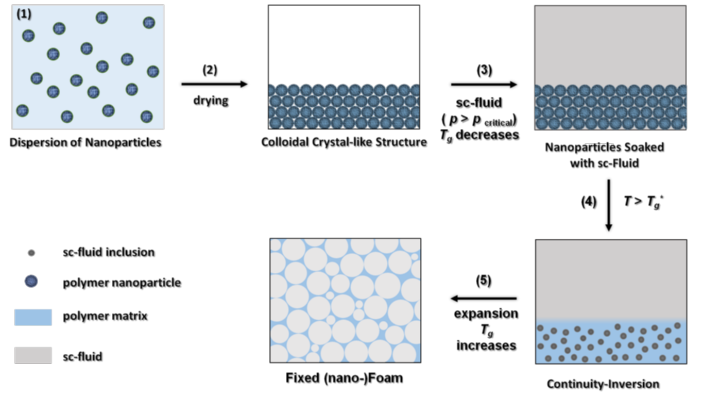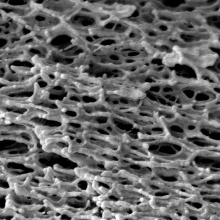Overview
Nanoporous materials are potential candidates for a wide range of applications. For example, porous polymers/polymer foams can be used as insulation materials, while inorganic or hybrid materials are widely used in heterogeneous catalytic applications. An important parameter that influences the usage and properties of nanoporous polymers is the pore size. However, adjusting and controlling pore sizes is a challenge encountered by scientists nowadays. Recently, the Nanofoams by Continuity Inversion of Dispersion (NF-CID) method has been developed to synthesize nanoporous polymers with adjustable pore sizes (Fig. 1) [1].

Following the NF-CID method and within the framework of the Collaborative Research Center CRC 1333 at the University of Stuttgart, we aim to synthesize nanoporous polymers based on polystyrene & poly(methylmethacrylate) with adjustable pore sizes (5 < dpore/nm < 50), geometry and morphology as tailor-made substrates for molecular heterogeneous catalysis in confined geometries. Furthermore, in cooperation with the workgroup of Prof. Dr. J. Bill (Institute of Material Science, workgroup for Bioinspired Materials & Systems) the nanoporous polymers will be subject to a multi-cyclic mineralization reaction [2] to form a layer of metal oxides (e.g. ZnO,ZrO2,SiO2, Al2O3 or TiO2) on the pore walls of the nanoporous polymers (Fig. 2) [3, 4], to which catalysts can finally be attached.

Bicontinuously structured microemulsions consisting of polar and nonpolar nanodomains (liquid confinement) might facilitate the transport of molecules with different polarities into and out of the nanoporous hybrid material. Thus, in cooperation with the workgroup of Prof. Dr. S. Laschat (Institute of Organic Chemistry, University of Stuttgart), microemulsions, e.g. H2O/NaOH, toluene/reactants and the sugar surfactant n-octyl b-d-glucopyranoside (C8G1), are used to study the role of liquid confinement in asymmetric Rh catalysis. As a benchmark reaction, the 1,2-addition of phenylboroxine (2) to N-tosylimine 1 in the presence of [RhCl(C2H4)2]2 and chiral diene ligands was investigated [5].
References
- Strey, R., Müller, A.: Patent DE102010053064A1 (2010). https://patents.google.com/patent/DE102010053064A1/en
- Lipowsky, P., Hoffmann, R. C., Welzel, U., Bill, J., Aldinger, F.: Site-Selective Deposition of Nanostructured ZnO Thin Films fromSolutions Containing Polyvinylpyrrolidone. Adv. Funct. Mater.17, 2151-2159 (2007). https://doi.org/10.1002/adfm.200600399
- Qawasmi, Y., Atanasova, P., Jahnke, T., Burghard, Z., Müller, A., Grassberger, L., Strey, R., Bill, J., Sottmann, T.: Synthesis of nanoporous organic/inorganic hybrid materials with adjustable pore size. Colloid and Polymer Science. 296, 1805--1816 (2018). https://doi.org/10.1007/s00396-018-4402-z
- Qawasmi, Y.: Toward Confined Spaces in Polymers and Microemulsions for Catalytic Applications. PhD Thesis (2019).
- Deimling, M., Kirchhof, M., Schwager, B., Qawasmi, Y., Savin, A., Mühlhäuser, T., Frey, W., Claasen, B., Baro, A., Sottmann, T., Laschat, S.: Asymmetric Catalysis in Liquid Confinement: Probing the Performance of Novel Chiral Rhodium–Diene Complexes in Microemulsions and Conventional Solvents. Chemistry – A European Journal. 25, 9464–9476 (2019). https://doi.org/10.1002/chem.201900947
Cooperations
- Prof. Dr. Joachim Bill, Institute of Material Science (workgroup Bioinspired Materials & Systems), University of Stuttgart, Germany
- Prof. Dr. Sabine Laschat, Institute of Organic Chemistry, University of Stuttgart, Germany

Karina Abitaev
Guest Researcher

Thomas Sottmann
Prof. Dr.Professor


